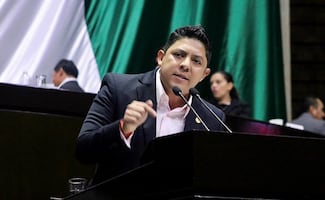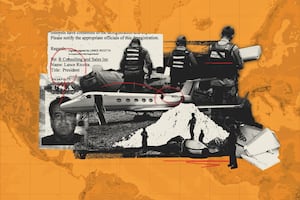Más Información

En SLP nunca ha existido una gobernadora y ahora hay una posibilidad real que así sea, asegura Ricardo Gallardo tras aprobación de "Ley Esposa"

Morena analiza disminución de pluris y elección popular de consejeros del INE: Monreal; serán revisadas en la reforma electoral, dice

Rastro de jets vinculados al narcotráfico lleva a un vendedor en California… y a un punto ciego de la regulación aérea en Estados Unidos

Secretaría Anticorrupción sanciona a dos empresas por buscar contratos con información falsa; imponen multa de miles de pesos

Banxico se despide de 2025 con otro recorte a la tasa de interés; queda en 7% por ajuste de 25 puntos base
Building a wall to control immigration from Mexico is hardly a new idea. In October 2006, President George W. Bush signed the Secure Fence Act to authorize and partially fund the construction of 700 miles of steel fences and other hurdles along the Mexican border. “This bill will help protect the American people,” Bush said at the time. “This bill will make our borders more secure.”
A wall has an obvious appeal. It represents a concrete and visible effort to keep immigrants out; it carries great symbolic power. It is a perfect policy for allaying the concerns of an electorate who might see immigrants as a source of their economic misfortune or a threat to national security. But would it really keep immigrants from illegally entering the United States?
From 1965 to 2010, the United States spent over US$40 billion (adjusted to 2010 values) to securing the border. These funds supported not just the fence and technology to prevent clandestine crossing, but also the number of officers patrolling the border, which increased from 1,500 in 1965 to over 20,000 in 2010.
Spending on the border first spiked after the 1986 Immigration Reform and Control Act (IRCA) – major legislation that increased border enforcement and imposed sanctions on employers hiring undocumented workers, and also opened the path to legalization for 2.3 million Mexicans already in the United States.
At first, the investment seemed to work. The number of undocumented migrants caught along the Mexico-U.S. border dipped after IRCA, from 1.6 million in 1986 to less than 900,000 in 1989. But this drop had more to do with legalization than to enforcement. Indeed, by 1993, the number of apprehensions on the border had climbed back to 1.2 million. From 1990 to 2010, the number of undocumented migrants from Mexico tripled, even though the amount spent on border control in the United States increased by more than tenfold during this same period.
Today, the tide has turned again. Since the end of the Great Recession, more Mexican immigrants have left the United States than have come here, according to the Pew Research Center’s analysis of government data from both countries.
This recent shift is not without precedent: migration rates after IRCA responded not just to immigration policy (enforcement or legalization), but also to relative wage and employment levels in Mexico and the United States, reminding us of the limits of this policy. Even major legislation such as IRCA cannot turn off immigration like a tap. It is difficult for the United States to develop an effective policy when the factors producing immigration are largely transnational or global, that is, beyond the control of any single nation. It is also hard for the country to settle on an immigration policy when there are interest groups with divergent views, such as employers or human rights groups, who favor migration, and workers who oppose it. These challenges often lead to policies that are not only mostly symbolic, but also carry unintended consequences. Building a wall is one such policy.
It is difficult for the United States to develop an effective policy when the factors producing immigration are largely transnational or global, that is, beyond the control of any single nation. It is also hard for the country to settle on an immigration policy when there are interest groups with divergent views, such as employers or human rights groups, who favor migration, and workers who oppose it. These challenges often lead to policies that are not only mostly symbolic, but also carry unintended consequences. Building a wall is one such policy.
So are the location-specific crackdowns that Border Patrol launched in the 1990s to deter undocumented migrants: Operation Hold the Line in the El Paso area in 1993; Operation Gatekeeper in San Diego in 1994; Operation Safeguard in Nogales, Arizona in 1995 and Operation Rio Grande in South Texas in 1997.
Each operation reduced the number of apprehensions in its respective sector. But the heightened security in particular areas ended up pushing undocumented migrants to less guarded and more dangerous routes along the border. It also moved migrant smuggling activities – once the work of former migrants themselves – into the domain of organized crime. The border became a much riskier place for not just for migrants, but also for Border Patrol officers.
As migrants moved to more remote regions of the border, the rate of apprehensions also dropped. Consequently, the cost to U.S. taxpayers of making one arrest along the border increased by more than fivefold, from $300 in 1992 to $1,700 in 2002.
Border enforcement also turned a mostly circular migrant flow into a system where migrants settled permanently. As it became costlier to cross the border (both in terms of physical danger and fees paid to smugglers), migrants started making fewer trips and staying in the United States for longer periods to recover the costs they incurred.

One might argue that previous border enforcement efforts haven’t been successful because they weren’t big enough. But historical evidence suggests that increasing enforcement is not always an effective deterrent of undocumented migration; it can introduce new threats to the border (more deaths for migrants and more involvement by criminal organizations), and can keep migrants in rather than out.
Improvements in enforcement do not come easy. Let’s take the “virtual fence” project. In 2006, the U.S. Department of Homeland Security (DHS) started investing in a suite of cameras and radars to enhance surveillance along the border. In 2011, then-DHS Secretary Janet Napolitano canceled the project, stating that it “does not meet current standards for viability and cost effectiveness,” – after USD$1 billion had already been spent.
Before we make the leap to spending billions (about US$8billion according to Trump but as much as US$25 billion according to some estimates) on building a wall, we need to know: What is the policy trying to achieve? How will we know if it is effective? And under what circumstances will we abandon the effort? The president’s signature plan to build a wall may work as a symbol, but there is little evidence to suggest it will make for effective policy.
Filiz Garip, a professor of sociology at Cornell University and a Public Voices fellow with the OpEd Project, is the author of “On the Move: Changing Mechanisms of Mexico-U.S. Migration.”
The views expressed in this article are not those of Reuters
News or EL UNIVERSAL
Noticias según tus intereses
[Publicidad]
[Publicidad]








